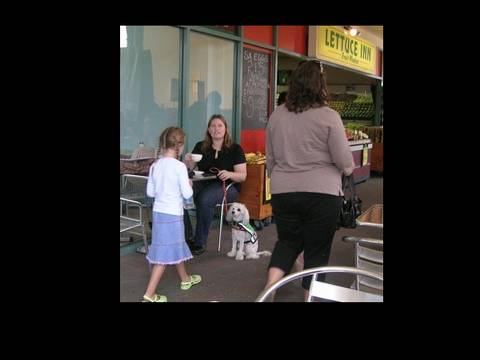|
|
|
Splfyr Alert Dogs.
When hypo and he alerts I praise him up and repeat 'low...low...low' so he associates my odour/behaviour with low sugar. I've done this since Day 1 and he began alerting naturally very early on. Alerting me for lows is saving me time and money as I have appointments that I still have to pay a fee for even if I can't make it. I used to have lots of hypos where it would take a while to recover, and I couldn't drive to my appointments. Thanks to Bonny I am able to catch them earlier and not need to eat so much, and need so much time to recover. Bonny is fantastic especially for the nocturnal hypos. Before I would either sleep through a hypo or only wake up in the 1s or low 2s. Now I am usually not lower than mid 3s before being woken. He wuffs and eventually whines and barks to get attention and has even gotten on top of me and pawed a few times, combined with his whining, to wake me up. When my glucose is becoming highish, Bonny lets me know by sniffing at my mouth and biting (gently) at my hands. If my hands are in my lap he will jump to get at them. This has resulted in better glucose control, my HbA1c's are the lowest they have ever been in over 20 years of Diabetes. I catch the highs in the 9-14 range instead of the previous 18-33 range! I have been told by close relatives that my breath does become a bit rank even if I am not having ketones. When my sugar is high I also praise Bonny, encourage him to smell my breath and hands, and repeat 'high...high...high' and so that goes well too. Bonny has developed a new talent which is for detecting failure of my insulin pump infusion sites. I change the cannula regularly every 3 days but occasionally it becomes occluded before this time. Bonny begins to sniff heavily and become very interested in the area, even through clothing (usually heavy denim), and I know the site needs changing. This saves high glucose levels creeping up. He usually ignores my pump, the tubing and the infusion site. 'Get' is his new command to get help for me when I am finding it difficult to get my glucose drink for treating a hypo. He goes to a relative in the house who then comes to my assistance. Bonny toilets on command 'pee-pee', does great heelwork, stays on command, can come on recall, automatic sit, sit on command both verbal and hand signal, stand, drop, refuses food, waits for his dinner very politely until given the command to eat. He knows 'down' to get off the couch and 'up' to come sit with me. We are in Grade 3 at obedience school but some of the things like food refusal and some hand commands I taught him myself as I have trained dogs before (mostly Rottweilers and assorted Spaniels, since age 9). I use the command 'leave it' when another dog comes past and instigates interest in Bonny. Then he sits and ignores the other dog's barking. The people at obedience school are wonderful and I submitted an article about Disability Dogs to the club's bi-montly newsletter. The instructors understand when Bonny's behaviour becomes a little erratic due to my highish blood glucose level (he wants to have my attention a lot more). The committee and instructors are very welcoming to us. We continue to educate the public about the role of Disability dogs, not patting working dogs, how to approach dogs safely and Diabetes in general (especially Type 1). Everyone has been interested and happy in having us visit their shops as we have many Disability dogs in our area. I usually walk into the store with Bonny and say 'I'm shopping/visiting with my Disability dog' and either get just a 'OK' or a very enthusiastic 'oh, he's cute, what does he do?' response. Most people want to pat him but see the badge on his coat discouraging this and I explain this further as they are usually disappointed. We have many Disability dogs in Adelaide as they are recognised for pulling wheel chairs, warning people of seizures and even one lady I know for her Narcolepsy. So going into shopping centres is not such a drama as some of you have experienced in other states. Splfyr Shangrila. I forgot to say that we call them Disability dogs in SA. I think the other states call them Assistance or Service dogs. Evelyn Lonergan Reynella, SA, Australia Phone : 0883873716 Email : splfyr@bigpond.com |



